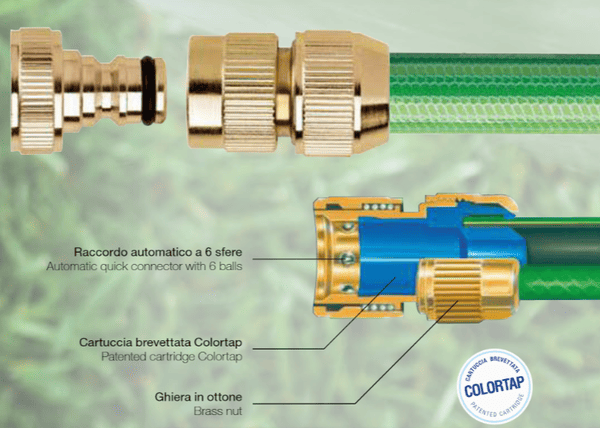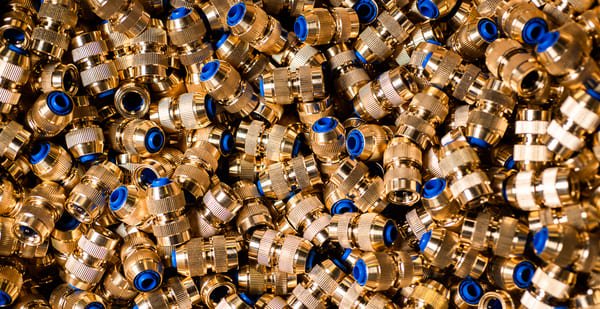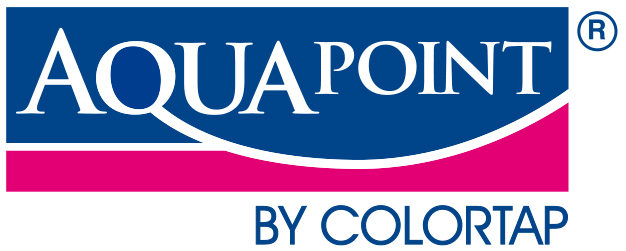Colortap brass fittings maintenance
Thanks to an insight it had back in the 1970s, today Colortap is recognized as a leader in the design and production of quick-connect brass fittings compatible with plastic ones: to ensure maximum compatibility with all PVC systems, the fittings are turned from brass bars using precision machinery.
Today, the decision to use metal is the mainstay and distinguishing feature that sets the company apart in the market, guiding it into the future.
How does this innovative system work? Based on the “Quick system” engagement, which is fully automatic due to the 6 balls. Components such as springs and balls are made of stainless steel to be corrosion resistant. The cartridge, designed and patented by us, is self-lubricating, which ensures the durability of the sealing O-rings.
An important aspect that must be considered, however, concerns maintenance: in fact, to ensure maximum durability of the fittings and optimal effectiveness, we recommend following a few simple but essential steps, thanks to which brass fittings will continue to function perfectly over time.
We had already dealt with how to protect outdoor faucets from frost with our tips. Let’s now see how to take care of and extend the life of brass fittings thanks to some maintenance tips.
6 general tips for brass fittings maintenance

Regular maintenance of Colortap brass fittings is essential to ensure reliability and sustained operation over time. Cleaning, lubricating, inspecting seals and checking connections are all steps that help keep the hydraulic system running efficiently and prevent future problems.
Here are some guidelines we recommend following to keep Colortap brass fittings in top condition.
Regular cleaning
– Clean the exterior surfaces of brass fittings periodically with a soft, damp cloth to remove dust, dirt, and lime residue.
– Avoid using harsh or abrasive cleaners that could damage the brass finish.
Lubrication of internal components
– The balls inside the brass socket require regular lubrication to maintain optimal connection and facilitate movement of the parts. Therefore, it is recommended to use a lubricant specifically for hydraulic components, such as silicone- or Teflon-based lubricant.
– Be sure to distribute the lubricant evenly over the balls to reduce friction and prevent premature wear.
IspeziGasket inspection
– Check gaskets regularly for signs of wear, cracking or deterioration. Replace damaged gaskets immediately to prevent leakage.
– Use gaskets that are compatible with brass and resistant to any chemicals in the system.
Checking connections
– Periodically check that all connections are tight and free of leaks. If leaks are noted, check the integrity of threads and gaskets, and tighten or replace as necessary.
– Avoid over-tightening connections to minimize damaging the fittings
Corrosion protection
– Although brass is resistant to corrosion, it is advisable to regularly inspect parts exposed to extreme environmental conditions, such as high humidity or corrosive chemicals.
– If necessary, apply a light coat of brass-specific protectant to preserve the surface.
Replacement of worn parts
– If there is significant wear or damage to fittings components, such as balls or seals, proceed with immediate replacement to maintain system integrity.
Maintenance of the balls in the brass fitting

To ensure an optimal connection between fitting and hose in Colortap systems, it is recommended to perform regular maintenance, which includes lubricating the balls in the brass fitting.
The first thing to do is to make sure that the system is shut off and pressure-free. Next you will need to thoroughly clean the area around the brass fitting to remove any residual dirt or dust.
Once the cleaning is complete, you can proceed by gently unscrewing the fitting to access the balls inside the brass connector. At this point, it is important to carefully examine the condition of the balls: if these show signs of wear, they may need to be replaced.
For lubrication, apply a small amount of lubricant specifically for hydraulic fittings, such as silicone or Teflon, directly to the balls. The lubricant should be distributed evenly to cover all spherical surfaces, avoiding the use of unsuitable products, which could damage the materials in the system.
Once the balls have been lubricated, you can proceed to reassemble the fitting carefully, tightening with the proper torque to prevent leakage or damage to the brass connector.
Finally, reactivate the system and check the integrity of the connection, ensuring that there are no leaks and that the fitting is functioning properly.
To maintain optimal performance and prevent connection problems, it is recommended to repeat lubrication periodically, based on system usage or, alternatively, every 6 months.
4 Benefits of cartridge maintenance

Maintaining an optimal self-lubricating and self-cleaning cartridge connection requires regular and careful maintenance.
Although the cartridge is designed to lubricate and clean itself, component maintenance, as seen for the balls in the brass fitting, is critical to ensure excellent performance over time.
Here are 4 benefits that come with it:
– improved performance: regular maintenance ensures that the cartridge always operates at maximum capacity. This ensures a perfect and consistent connection, reducing the risk of leakage or malfunction.
– extended service life: proper care of moving parts, such as balls and contact surfaces, prevents premature wear. This helps keep the cartridge and the overall system in optimal condition for a longer period.
– cartridge efficiency: although self-lubricating and self-cleaning, the cartridge benefits from regular maintenance to operate smoothly. Maintenance helps to prevent accumulation of dirt or debris that could affect the operation of the cartridge.
– system reliability: constant maintenance minimizes the risk of sudden failure, ensuring that the system remains reliable and operational at all times.
Regular maintenance is essential to maintain an optimal connection on the self-lubricating and self-cleaning cartridge, ensuring efficiency, longevity and reliability to the hydraulic system.
How to use a protective coating
Although brass is an extremely durable material, it is possible to apply a coating to further protect fittings from corrosion and wear, while at the same time giving them shine.
So how to properly apply a protective coating to brass fittings? Here are our tips.
Materials needed
– Specific protective coating for brass (spray or liquid)
– Soft cloth or sponge
– Mild degreaser (if needed)
– Protective gloves
– Brush (if using a liquid coating)
– Adhesive tape or protective film (to cover unaffected parts)
Procedure
1) Preparation of the fitting
– Cleaning: Before applying the coating, make sure the fitting is completely clean. Use a soft cloth or sponge to remove dust, dirt and grease from the surface of the fitting. If the fitting is very dirty, use a mild degreaser, then rinse and dry thoroughly.
– Inspection: Check for signs of corrosion or damage. If they are present, it is best to treat them before applying the coating.
2) Protection of unaffected areas
– Use masking tape or protective film to cover any areas of the fitting that should not be treated, such as threads or gaskets.
3) Coating application
– Spray: If using a spray coating, shake the can well and apply an even layer of product on the connector, keeping a distance of about 20-30 cm. Be sure to cover all exposed surfaces.
– Liquid: If the coating is liquid, apply it with a brush, spreading the product evenly. It is important to cover all exposed areas to ensure complete protection.
– Multiple layers: in some cases, it may be necessary to apply multiple layers of coating to ensure optimal protection. Follow the manufacturer’s instructions regarding drying time between applications.
4) Drying
– Allow the coating to dry according to the manufacturer’s directions. Avoid touching or using the fitting until the coating is completely dry.
5) Removing the protections
– Once the coating is dry, carefully remove the tape or protective film from the untreated parts of the fitting.
6) Final check
– Check that the coating has been properly applied to all surfaces and that there are no uncovered areas. The fitting is now protected and ready for use.


